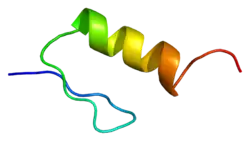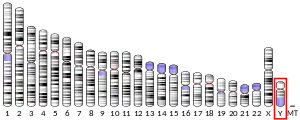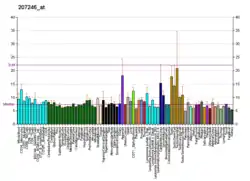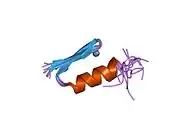ZFY
Zinc finger Y-chromosomal protein is a protein that in humans is encoded by the ZFY gene of the Y chromosome.[3][4]
| ZFY | |||||||||||||||||||||||||||||||||||||||||||||||||||
|---|---|---|---|---|---|---|---|---|---|---|---|---|---|---|---|---|---|---|---|---|---|---|---|---|---|---|---|---|---|---|---|---|---|---|---|---|---|---|---|---|---|---|---|---|---|---|---|---|---|---|---|
 | |||||||||||||||||||||||||||||||||||||||||||||||||||
| |||||||||||||||||||||||||||||||||||||||||||||||||||
| Identifiers | |||||||||||||||||||||||||||||||||||||||||||||||||||
| Aliases | ZFY, ZNF911, zinc finger protein, Y-linked, zinc finger protein Y-linked | ||||||||||||||||||||||||||||||||||||||||||||||||||
| External IDs | OMIM: 490000 HomoloGene: 88465 GeneCards: ZFY | ||||||||||||||||||||||||||||||||||||||||||||||||||
| |||||||||||||||||||||||||||||||||||||||||||||||||||
| |||||||||||||||||||||||||||||||||||||||||||||||||||
| |||||||||||||||||||||||||||||||||||||||||||||||||||
| |||||||||||||||||||||||||||||||||||||||||||||||||||
| Wikidata | |||||||||||||||||||||||||||||||||||||||||||||||||||
| |||||||||||||||||||||||||||||||||||||||||||||||||||
This gene encodes a zinc finger-containing protein that may function as a transcription factor. This gene was once a candidate gene for the testis-determining factor (TDF) and was erroneously referred to as TDF.[4]
Humans express a single ZFY gene with two splice variants. While mice express two paralogous copies, Zfy1 and Zfy2.[5] During spermatogenesis, wrongful expression of either Zfy1 or Zfy2 results in programmed cell death, apoptosis, at the mid-pachytene checkpoint. In mice, Zfy genes are necessary for meiotic sex chromosome inactivation (MSCI). In Zfy knockout spermatocytes, sex chromosomes are incorrectly silenced. Thus, Zfy performs three functions at the mid-pachytene checkpoint: (1) promote MSCI, (2) monitor MSCI progress, and (3) execute cells, via apoptosis, that fail to undergo MSCI.[5]
In humans, ZFY is most broadly expresses in the testis and prostate. However, 20 other tissues also express ZFY, such as esophagus, urinary bladder, bone marrow, small intestine, appendix and gall bladder.[6]
Disorders associated with the ZFY gene include campomelic dysplasia, cystadenofibroma, and Frasier syndrome.[7]
References
- GRCh38: Ensembl release 89: ENSG00000067646 - Ensembl, May 2017
- "Human PubMed Reference:". National Center for Biotechnology Information, U.S. National Library of Medicine.
- Müller G, Schempp W (April 1989). "Mapping the human ZFX locus to Xp21.3 by in situ hybridization". Human Genetics. 82 (1): 82–4. doi:10.1007/BF00288279. PMID 2497060. S2CID 27908892.
- "Entrez Gene: ZFY zinc finger protein, Y-linked".
- Vernet N, Mahadevaiah SK, de Rooij DG, Burgoyne PS, Ellis PJ (December 2016). "Zfy genes are required for efficient meiotic sex chromosome inactivation (MSCI) in spermatocytes". Human Molecular Genetics. 25 (24): 5300–5310. doi:10.1093/hmg/ddw344. PMC 5418838. PMID 27742779.
- "ZFY Gene". GeneCards. Retrieved 2019-04-15.
- "MalaCards: Search Human Diseases - ZFY". Mala Cards. Retrieved 2019-04-15.
Further reading
- Merchant-Larios H, Moreno-Mendoza N (2002). "Onset of sex differentiation: dialog between genes and cells". Archives of Medical Research. 32 (6): 553–8. doi:10.1016/S0188-4409(01)00317-4. PMID 11750730.
- Kochoyan M, Havel TF, Nguyen DT, Dahl CE, Keutmann HT, Weiss MA (April 1991). "Alternating zinc fingers in the human male associated protein ZFY: 2D NMR structure of an even finger and implications for "jumping-linker" DNA recognition". Biochemistry. 30 (14): 3371–86. doi:10.1021/bi00228a004. PMID 1849423. S2CID 24544613.
- Kochoyan M, Keutmann HT, Weiss MA (July 1991). "Alternating zinc fingers in the human male associated protein ZFY: refinement of the NMR structure of an even finger by selective deuterium labeling and implications for DNA recognition". Biochemistry. 30 (29): 7063–72. doi:10.1021/bi00243a005. PMID 1854720.
- North M, Sargent C, O'Brien J, Taylor K, Wolfe J, Affara NA, Ferguson-Smith MA (May 1991). "Comparison of ZFY and ZFX gene structure and analysis of alternative 3' untranslated regions of ZFY". Nucleic Acids Research. 19 (10): 2579–86. doi:10.1093/nar/19.10.2579. PMC 328173. PMID 2041734.
- Palmer MS, Berta P, Sinclair AH, Pym B, Goodfellow PN (March 1990). "Comparison of human ZFY and ZFX transcripts". Proceedings of the National Academy of Sciences of the United States of America. 87 (5): 1681–5. Bibcode:1990PNAS...87.1681P. doi:10.1073/pnas.87.5.1681. PMC 53546. PMID 2308929.
- Affara NA, Chambers D, O'Brien J, Habeebu SS, Kalaitsidaki M, Bishop CE, Ferguson-Smith MA (April 1989). "Evidence for distinguishable transcripts of the putative testis determining gene (ZFY) and mapping of homologous cDNA sequences to chromosomes X,Y and 9". Nucleic Acids Research. 17 (8): 2987–99. doi:10.1093/nar/17.8.2987. PMC 317707. PMID 2498838.
- Lau YF, Chan KM (December 1989). "The putative testis-determining factor and related genes are expressed as discrete-sized transcripts in adult gonadal and somatic tissues". American Journal of Human Genetics. 45 (6): 942–52. PMC 1683462. PMID 2511751.
- Page DC, Mosher R, Simpson EM, Fisher EM, Mardon G, Pollack J, McGillivray B, de la Chapelle A, Brown LG (December 1987). "The sex-determining region of the human Y chromosome encodes a finger protein". Cell. 51 (6): 1091–104. doi:10.1016/0092-8674(87)90595-2. PMID 3690661. S2CID 7454260.
- Tricoli JV, Bracken RB (February 1993). "ZFY gene expression and retention in human prostate adenocarcinoma". Genes, Chromosomes & Cancer. 6 (2): 65–72. doi:10.1002/gcc.2870060202. PMID 7680890. S2CID 7796123.
- Erlandsson R, Wilson JF, Pääbo S (May 2000). "Sex chromosomal transposable element accumulation and male-driven substitutional evolution in humans". Molecular Biology and Evolution. 17 (5): 804–12. doi:10.1093/oxfordjournals.molbev.a026359. PMID 10779541.
- Mittwoch U (2001). "Three thousand years of questioning sex determination". Cytogenetics and Cell Genetics. 91 (1–4): 186–91. doi:10.1159/000056842. PMID 11173854. S2CID 20017749.
- Skaletsky H, Kuroda-Kawaguchi T, Minx PJ, Cordum HS, Hillier L, Brown LG, Repping S, Pyntikova T, Ali J, Bieri T, Chinwalla A, Delehaunty A, Delehaunty K, Du H, Fewell G, Fulton L, Fulton R, Graves T, Hou SF, Latrielle P, Leonard S, Mardis E, Maupin R, McPherson J, Miner T, Nash W, Nguyen C, Ozersky P, Pepin K, Rock S, Rohlfing T, Scott K, Schultz B, Strong C, Tin-Wollam A, Yang SP, Waterston RH, Wilson RK, Rozen S, Page DC (June 2003). "The male-specific region of the human Y chromosome is a mosaic of discrete sequence classes". Nature. 423 (6942): 825–37. Bibcode:2003Natur.423..825S. doi:10.1038/nature01722. PMID 12815422.
- Agate RJ, Choe M, Arnold AP (February 2004). "Sex differences in structure and expression of the sex chromosome genes CHD1Z and CHD1W in zebra finches". Molecular Biology and Evolution. 21 (2): 384–96. doi:10.1093/molbev/msh027. PMID 14660691.



![1klr: NMR Structure of the ZFY-6T[Y10F] Zinc Finger](../I/PDB_1klr_EBI.jpg.webp)
